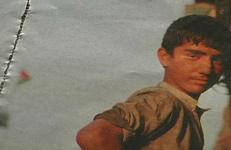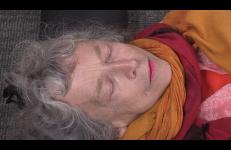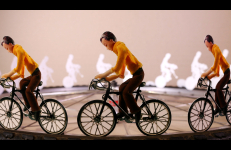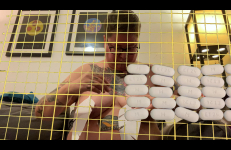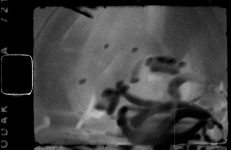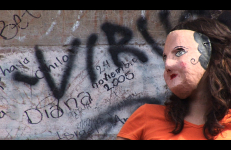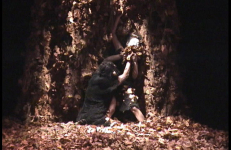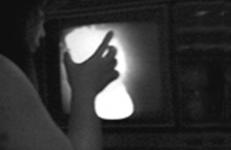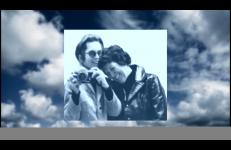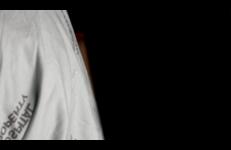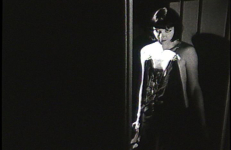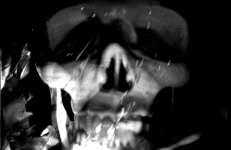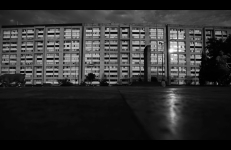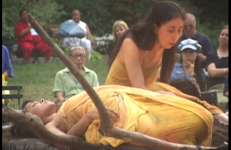Letters, conversations: New York-Chicago, Fall, 2001 is driven by a fragmented voice-over that criss-crosses between two female voices – one seemingly formal and distant, the other more conversational and intimate. It begins with short excerpts from emails, phone conversations and letters between friends, family, ex-lovers and acquaintances in the days and weeks following September 11th, 2001.
Death and Dying
Linda Montano is interviewed by Janet Dees, Curator at the Mary and Leigh Block Museum, Northwestern University.
Since the 1960s, Linda Montano has aimed to blur the distinction between art and life with her performance and video work. Delving deep into subjects like death, spirituality and personal trauma, she is seen as an influential figure in feminist performance art.
Listen To This is a fragment of collective memory that finds critical relevance in contemporary Queer discourse. Tom Rubnitz weaves narration, image, and a form of temporality, dislocated from ‘real time’, into a video where artist and AIDS activist David Wojnarowicz’s loss and anger is palpable.
In the late 1990’s I presented a slide lecture on how my art references impermanence and dying. In 2014, video artist and editor Tobe Carey scanned the slides from the lecture and we collaged together the spoken narrative, images both of my own work and also of death rituals from many different cultures, creating an Endgame-like collage. There are images from my study in Benares at the Burning Ghats, images from my film Mitchell’s Death, and descriptions of ways that my work and death seem to be close cousins.
Unable to locate the grave of Letine—leader of a 19th century acrobatic cycling troupe (and buried locally)—I went home and wondered.
And then I made this film.
Equal parts experimental animation, stylised domestic drama, and autobiography accompanied by reflections on mortality, filmmaking, and magic. Plus more.
— Paul Tarragó
Treating the problem of anorexia nervosa from the parents' perspective, Rosler presents a mother and father speaking about the tragedy of their daughter's death as a result of dieting. The conversation turns toward the irony of self-starvation in a land of plenty and toward the international politics of food, where food aid is used as a negotiating tool. Confronting a serious issue, Rosler simultaneously sets into play the confessional form and the ghoulish staginess of talk show dramatics.
In The Lost Art of the Future, Cuthand talks about artists he has known who have passed while living with HIV/AIDS, and the art he wishes he had been able to see them make if their lifetimes had been longer.
A surreal vision of one man's endeavor to contact the spirit world and come to terms with nightmares of a mysterious death. A séance is orchestrated according to instructions written in 1920 by revered parapsychologist Hereward Carrington, voiced here by novelist Lynne Tillman. Roses, seen as light by spirits, are placed in the room but these flowers are plastic; a requisite round table is surrounded by wooden chairs that remain empty despite stern warnings to never sit alone.
Lumbreras is the historical and archeological place of the bones, ruins and detritus. A window thought time, an ancestral rhythm of the audiovisual materials.
Tanaka passionately evokes the loss of her mother by visually recreating the ominous and disempowering feeling of isolation that accompanies mourning. The tape enunciates the painful phases of grieving: the claustrophobic results of dealing with the inevitability of death, the transitional void where one is lost between the comfortable orientation of one’s world and Nothing, and the new sense of clarity where images from the past resurface from the abyss of forgetfulness.
Its dream-like unfolding, amid the imposing titular Mexican landscape, results from a randomizing strategy modeled on the "Exquisite Corpse" parlor game adopted by the Surrealists of the 1920s.
Its dream-like unfolding, amid the imposing titular Mexican landscape, results from a randomizing strategy modeled on the "Exquisite Corpse" parlor game adopted by the Surrealists of the 1920s.
Using performance as a means of personal transformation and catharsis, Mitchell’s Death mourns the death of Montano’s ex-husband. Every detail of her story, from the telephone call announcing the tragedy, to visiting the body, is chanted by Montano as her face, pierced by acupuncture needles, slowly comes into focus then goes out again. The chanting is reminiscent of Buddhist texts, while the needles signify the pain that is necessary for healing and understanding.
An evening-length collaboration work with the celebrated avant-garde pianist Margaret Leng Tan. The stage set is by Eiko & Koma and the lighting is by David Ferri.
Commissioned by and premiered at Japan Society, New York, October 18-20, 2007, celebrating Kazuo Ohno's 101th Birthday and the 100th anniversary of Japan Society.
During a video workshop, the Ikpeng community decides to act out the myth of the origin of the tattooing ceremony. The mythical hero, Maragareum, dreams about the collective death of the villagers of his friend’s Eptxum’s village. Arriving in this village, he finds, in fact, that everyone is dead. As night falls, he hides in the hut, and observes and learns the Moyngo ceremony from the spirits of the dead.
Directed and photographed by Karané, Kumaré, and Natuyu Ikpeng; edited by Leonardo Sette.
In Ikpeng with English subtitles.
In this classic personal elegy, Kubota mourns her father's death and recounts the last days of his life. Reflecting on Kubota's use of the video medium, the television emerges as the link between Kubota and her father, with the melodramatic crooning of Japanese pop singers providing a backdrop for Kubota's real-life tragedy.
This title is also available on Surveying the First Decade: Volume 1.
My mother's life and death were both extraordinarily epic. A painter who art therapized herself out of depression. Her resiliency could have rewarded her with a Badge of Courage; alchemizing trauma into art, activism and humor. Modeling these gifts for me, I look at our lives which could have been charted and copied page for page, letter by letter, and I recognize that I have imitated her style, not missing a beat.
— Linda Montano
Nascentes Morimur grew out of a series of works on autopsy — an earlier video and a number of still images — that were exhibited together as Like a Shipwreck We Die Going Into Ourselves. In an interview on that body of work Wojtasik said: “In the end, doubt has been raised. One starts to look around the room at the living and the dead and question how real one’s own and others’ identities are. At the same time, one may be filled with simultaneous wonder and dread at the sheer fact of being alive in the body.”
-- Kustendorf Film and Music Festival
Invoking a biblical story of life coming from dry bones, Condit constructs an experimental narrative about an older woman’s confrontation with her own mortality after the death of her mother. The bone represents the promise of youth and hope—a promise jealously coveted by the young, but needed more by those grown old. Inverting cultural values, Condit represents feminine youth as a mannequin, and seeks humanity in the form of the older woman, who is reborn by overcoming her fear of death.
This sensualist's dream follows Louise Brooks look-alike Rodney O'Neal Austin on his search for the Beloved. From the cabaret to opium dens and dancing graces this homage to early sound film explores a world teeming with the mysteries of longing and death. Music by Trance Mission and Minnie Pearl Necklace.
The archive is not a repository of cultural memory, but of dreams, a bank of dream material. Both memory and archive embrace death, but from contrary positions. The archive is a mausoleum that pretends to be a vast garden. Memory is an irradiated zoo in which the various animals are mutating extravagantly and dying slowly.
-- Steve Reinke
In 1998 I made a sculpture of a decapitated head. I featured it in a photo and video. I thought of the head as a character whose adventures would be documented. The name O’Malley was inspired by Chicago’s Irish heritage (I was living in Chicago then). O’Malley’s Head Part 1 was a photo of the head placed on top of the garbage cans in the alley behind my apartment building. I lived right by an exit ramp from the Kennedy Expressway, one of the last before you reached downtown from O’Hare Airport. Sometimes people would exit there and dump things.
This is the gaze that is reflected in the dark obsidian mirror.
A voice for which an event impossible to internalize remains distant. An event that in its distance does not cease to make the narration of something that should not take place anywhere foreign. The military massacre against unarmed students in 1968.
Offering was co-commissioned by Dancing in the Streets (New York), the Walker Art Center (Minneapolis, where the proscenium version premiered January 9, 2003) and the University of Arizona (Tucson).
Offering is a ritual of regeneration after loss. People everywhere have lost ideals and landscapes that were dear to them. Offering was originally developed as a mobile outdoor work. This transportable dance or living site "installation" can be brought into communities to serve a communal need for a ritual of mourning.




